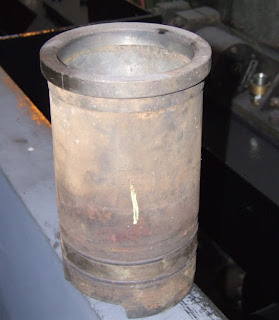One of the first jobs on getting Queen Anne inside the locoshed was to determine the condition of the engine. The "bonnet" superstructure was removed along with the radiator cowl and the radiator to allow all-round access to the engine.
The crankshaft did not seem willing to turn, and on removal of the exhaust manifold and silencer, the latter was found to be half full of water. The loco has a vertical exhaust pipe and the open end had not been covered when it was laid up out of use, so rainwater had accumulated inside the engine.
An attempt was made to turn the crankshaft using a bar in one of the holes in the flywheel and a jack against the chassis, but it was stuck fast. On removing the four cylinder heads, it was found that water had got into cylinders nos. 1 and 2 because their exhaust valves had been open. Cylinders 3 and 4 were dry.
There is another Ruston shunter at Aviemore - a 165 HP 0-4-0 with a 6VPH engine. This had seized because it had been stored with its heads removed, but had successfully been freed by pouring Tesco Cola into the bores and leaving it for a few days!
After trying various methods for freeing Queen Anne's engine without success, it was decided to try the "Cola" method. However, in this case it didn't work and simply resulted in more pitting and corrosion of the liners. That may have been due to an electrolytic effect between the aluminium pistons and iron liners.
The seized pistons (nos 1 and 2) were finally freed by removing the big end caps of the connecting rods and using a hydraulic jack between the top of the pistons and a metal plate secured to the head studs. All the pistons were then removed - they have to go downwards and out through the crankcase doors as the big ends are larger than the bores.
Although there was some surface corrosion in the crankcase under nos 1 & 2 cylinders, the crankshaft turned easily, and the big end journals were easily cleaned up.
 |
| One of the original liners |
The liners were all badly corroded and were too far gone to be honed. However the pistons seemed in good condition, although the rings were all gummed up. Most of the rings broke while trying to free them from the ring grooves. The gudgeon pins and big end shells seemed in good condition.
The crankcase was badly "sludged" with black sooty deposits, because a non-detergent lubricating oil had been used, but that could easily be cleaned up using paraffin. Because the big end bearings didn't seem worn, it was assumed that the main bearings were OK as there wasn't any sign of movement. Examination of the main bearings would require removal of the flywheel and lifting the engine block from the chassis - a lot of work.
The cylinder heads seemed basically OK, but would need a complete clean and de-coke. The rockers seemed OK although it was noted that one of them had been repaired by brazing. It was a good repair, but if a new rocker could be found, it would be replaced.
 |
| Exhaust rocker with brazing repair |
On removing the valves, the exhaust valve of head no. 1 was found to be severely pitted by the water ingress, and could not be ground back into shape. The valve seat was also too badly pitted to be ground in and would need a new cast-iron insert fitted. All the other valves were capable of being ground in.
 |
| Badly pitted exhaust valve |
All the cylinder head studs were found to be very wasted due to corrosion, and would need to be replaced. One of the covers for the water jacket had cracked due to freezing - it was simple to make a replacement and no other frost damage was found. The water drain cock for the block was blocked with rusty sludge and there was a lot of sludge in the water galleries. The injectors were unlikely to work after being inactive for so long and one of the nozzles had become very badly pitted and would probably need replacing while the other water-damaged nozzle was not too bad and might be salvageable.
 | |
| The dismantled engine |
So the following replacement parts would be required :-
- 4 off cylinder liners & seals
- 4 off head gaskets
- 4 off piston ring sets
- 1 off exhaust rocker
- 1 off exhaust valve

No comments:
Post a Comment